Accurate inventory management is essential to running a business, whether retail, wholesale, or both. If you sell products, then your inventory is your business. If you’re not keeping track of your inventory value and when you need to reorder, then you’re losing money. Products are assets, and you need to set up a system of asset management.
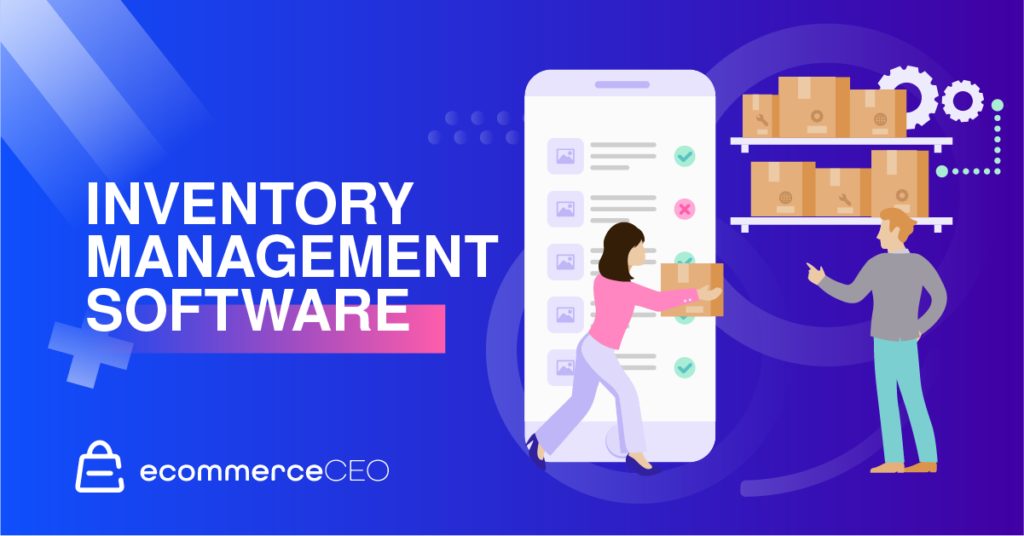
You’re wasting money on acquiring stock your customers don’t want or missing the opportunity to sell the items they really want.
Fortunately, a wide range of inventory-related technology is available. Many inventory management apps offer custom options that are sure to fit your business’s needs.
The only question is: which inventory management tools should you use? We’ll cover the best inventory management software options on the market today to help you decide.
What is an Inventory Management System?
A quality system ensures that you can track, manage, and organize your product sales, your materials purchases, and other production processes across business operations.
Since the development of inventory management software, gone are the days of tracking all of this information with paper and pencil. Instead, businesses can now use barcodes or (RFID) radio-frequency identification to identify which shipments have come in and where their products have been shipped.
Using a proper system allows you to reduce the time and effort put into basic tracking, and you’ll be able to create a more robust and efficient system, with increased inventory visibility.
How Can Inventory Management Software Help My Business?
Implementing the best inventory management solution for your business can help you reap many benefits, including saving time and money.
For instance, you’ll be able to automate inventory tracking to see how much product you have in stock in real-time. This allows your business to be more agile as it responds to customers’ needs almost immediately. It makes stock management easy and accurate.
The ability to pair inventory software with barcode scanning will allow your company to process orders quickly and provide faster shipping for customer orders, ultimately providing a better customer experience.
Let’s examine additional ways that ecommerce inventory management software can generate cost savings for your growing business:
- Effectively managing your inventory will allow you to purchase from your vendors only when you need to. This means you’re not paying for unnecessary warehouse space, and you can get better prices by ordering in larger quantities.
- An organized warehouse allows you to efficiently store merchandise that streamlines your process, saving time and providing more space.
- Increased productivity by ensuring that your employees aren’t wasting their time hunting for merchandise, tracking down orders, or trying to make space in a crowded warehouse.
- A good inventory management system comes with advanced reporting, which allows you to track which products are selling well. Some software can even include demand forecasting capability so you can avoid having excess inventory on hand.
- Your business will benefit from better customer service and can even prevent your business from breaching service-level agreements.
- Once you consolidate your activity and deploy efficient routing, your fixed assets (trucks, forklifts, and pallet jacks) will benefit from reduced wear and tear.
There are three major challenges to inventory management: optimizing costs, not having enough warehouse space, and the necessity to save time. If your business has a handle on all three, it can ensure products are permanently available and shipped to customers in a timely fashion while keeping costs down.
Can I Use Excel as an Inventory Tracking system?
If your company has Microsoft Office, you have a ready-to-go inventory tracking system. Microsoft Excel allows you to track all the data you need to manage your inventory and supply chain and keep your business organized.
Going this route may be the best option for a small company on a budget. However, there are several things to take into consideration when going this route.
Excel vs. Inventory Tracking Software
We’ve discussed that good inventory management is crucial for optimizing the supply chain and distribution. This applies to any business, from the fashion industry to construction and everything in between.
A lot of entrepreneurs and small-to-medium businesses use Excel or a similar spreadsheet setup. So, let’s look at the advantages and limitations of using this option.
Benefits of Using Microsoft Excel
Excel is user-friendly, and the cost is low. It’s often already used by companies for other applications, from accounting to scheduling.
There are several things you need to have in place to use Excel:
- Your products must include an SKU reference, name, description, price per unit, and tax (if applicable). Additional data, such as a barcode, labels, and the location of the supplier and warehouse, can also be helpful.
- Inventory tracking needs to be entered and updated manually.
- A customer database with the customer’s name, invoice number, billing name, business address, and shipping address.
- A feature that generates estimates and purchase orders.
Drawbacks of Using Microsoft Excel
Excel is not suited to more complicated order management. Manually managing inventory is a waste of time, and it also leads to an increased risk of making mistakes.
Other issues include:
- Excel isn’t automated, so you can’t manage order tracking and inventory in real time.
- One employee can only access and change it at a time.
- Excel comes with a risk of data loss.
1. inFLOW
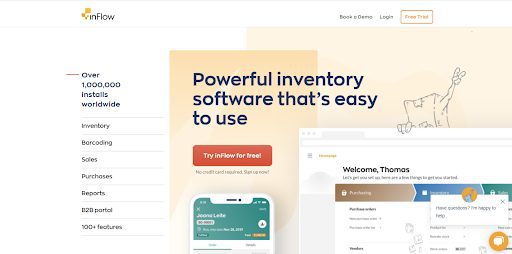
inFlow Inventory has a couple of things going for it: it’s one of the most affordable options, and it’s easy to use. A variety of businesses, including retail shops, IT and tech companies, and higher education institutions use this platform. It’s a complete warehouse management system (WMS) that streamlines things regardless of how many additional warehouses you operate.
Key Features:
- Automated inventory tracking features
- It has a great mobile app that supports barcode scanning
- Detailed sales, purchasing, inventory, and sales tax reports
- Purchase orders, drop shipping, email POs and receipts, and supports multiple ship-to addresses
- Pays vendors in batch payments and partial payments, and tracks balances and credits
- Manages vendors with contact information and order histories
- Scans and generates barcodes
- Mobile apps to manage inventory items on the go, available for both Android and iOS.
Integrations:
- Shopify
- Amazon
- WooCommerce
- Squarespace
- Zapier
Pricing:
- Light version: $71 per month (100 sales orders per month)
- Standard: $179 per month (1,000 sales orders per month)
- Plus: $449 per month (10,000 sales orders per month)
If you need to process over 10,000 sales orders per month, you need to contact them about a custom solution.
Free Trial: Yes, there is a 14-day free trial
2. ZOHO Inventory Software

is online software that provides warehousing management, order fulfillment, and inventory control. It integrates with other Zoho tools, such as their customer relationship management (CRM) software, to make operations for business smoother for everyone – not just inventory managers.
This cloud-based inventory management company gives you all the inventory control systems you need.
Features
- Item grouping and bundling
- Multi-warehouse management
- Serial number, batch tracking, and expiration date tracking
- Sales order management
- Invoicing
- SKU generator
- Packaging and shipping
- Vendor price-lists
- Purchase order and billing solutions
Integrations
- WooCommerce
- Shopify
- Amazon
- eBay
- Etsy
- UPS
- USPS
- FedEx
- DHL
Pricing
- Free version: Supports up to 50 orders per month for two users and one warehouse.
- Standard version: $59 per month (billed annually) for up to 15000 orders per month for three users and two warehouses.
- Professional version: $99 per month (billed annually) for up to 7500 orders per month for five users and five warehouses.
- Premium version: $159 per month (billed annually) for up to 15000 orders per month for ten users and seven warehouses.
- Elite version: $239 per month (billed annually) for unlimited orders for fifteen users and fifteen warehouses.
Free trial: Zoho Inventory offers a demo account and a free option.
3. ecom Dash
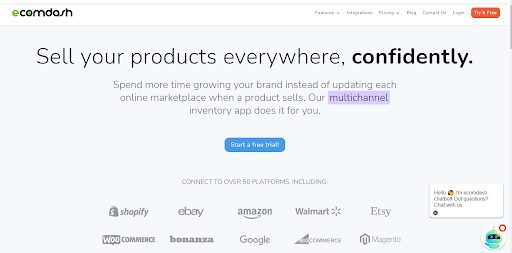
Ecom Dash will update your product quantities no matter how many online marketplaces or web stores your company sells on. Its mission is to help companies manage their inventory more effectively, allowing them to grow their business.
Features
- Update product quantities 24/7 with automated multiple sales channels inventory synchronization
- The ability to manage inventory across multiple platforms and warehouses
- Order management consolidation within one dashboard
- The ability to keep track of serialized inventory, bundled items, and manufactured items
Integrations
- Amazon
- Etsy
- WooCommerce
- Walmart
- Etsy
- Shopify
- UPS
- FedEx
- DHL
Pricing
- Free version: Offers 30 orders per month with unlimited sales channels, users, product listings, email, and chat support. It also includes synching for one hundred products and a complimentary, 1-hour onboarding call.
- Pro version: Starts at $25 per month and includes everything in the free plan plus dropshipping functionality, mobile app, free phone support, and more. Includes 30 orders per month, pricing is available for additional orders.
Free Trial: Ecom Dash offers a free version.
4. NetSuite by Oracle
NetSuite inventory management software offers work order management, logistics, data management, and planning features, besides inventory and order management.
Features
- Multi-location fulfillment allows you the ability to eliminate multiple shipments for a single order
- Demand-based replenishment to manage reorders and maintain preferred levels of stock
- The ability to trace inventory using lot and serial tracking
- Printable bar codes and item labels that include transaction numbers
- Forms to assist in day-to-day supply chain management and operations, including inventory count sheets and manufacturing dispatch lists
- Periodic inventory counts that automatically calculate on-hand item quantities at any location
Integrations
- Available on request
Pricing
Users subscribe to the service for an annual license fee. It includes the core platform, optional modules, and the total number of users. There is also a one-time fee for the initial setup. You must contact NetSuite to discuss your company’s needs and pricing.
Free Trial: No. However, they offer a free product tour.
5. Orderhive
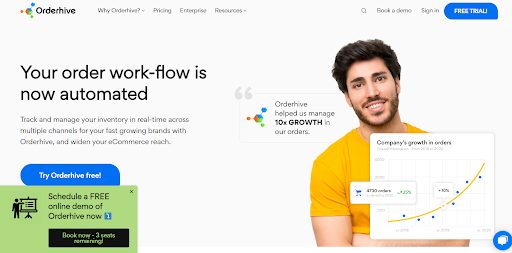
Orderhive offers cloud-based inventory management business software that handles order fulfillment, ecommerce automation, and product movement.
Features
- Real-time inventory synchronization
- Quick reports and analytics
- Multichannel integration
- Order management software that easily processes orders, including generating invoices, managing returns, and allowing drop shipping and back orders
Integrations
- Amazon
- Shopify
- WooCommerce
- FedEx
- eBay
- Quickbooks
- PayPal
- Stripe
- Walmart
- Etsy
- USPS
- UPS
- Google Sheets
Pricing
- Free version: Offers basic inventory management for Shopify Users.
- Lite version: $44.99 per month with unlimited integrations, unlimited SKUs, and chat and email support during onboarding.
- Starter version: $134.99 per month with many automations and chat support at each stage of setup
- Growth version: $269.99 per month, which includes Orderhive API access and 4 hours of employee training
Orderhive customizes the enterprise version for your business. Pricing is available upon request.
Free Trial: Yes, there is a 15-day free trial that does not require a credit card upon signing up.
6. SkuVault

SkuVault prides itself on offering a system that provides solutions for the most challenging ecommerce issues. Their website claims that their inventory optimization system can help you achieve 87% faster fulfillment and 83% fewer mis-ships.
Features
- Advanced inventory tracking with features like barcode scanning across warehouse locations
- Demand planning and forecasting with reports that include sales history
- Automated features that simplify the running of your warehouse and increase speed and accuracy
- Offers onboarding packages and training
- Advanced purchase order features
Integrations
- Amazon
- eBay
- Etsy
- Shopify
- WooCommerce
- Square
- Salesforce
Pricing
- Growth version: $269 per month (billed annually) for two users and up to 2,000 orders per month
- Pro version: $409 per month (billed annually) for two users and up to 5,000 orders per month
- Enterprise version: $809 per month (billed annually) for two users and up to 20,000 orders per month
Free Trial: No. They offer a free demo.
7. SellerCloud
SellerCloud is an ecommerce platform focused on omnichannel selling. It offers the ability to manage inventory, publish product listings, and fulfill orders.
Features
- A single platform that can handle all inventory management and fulfillment
- List on multiple channels directly from Seller Cloud
- Set shipping preferences for each product
- Synchronization of inventory across all sales channels
- Multi-warehouse management
- Reserve inventory for specific channels and deals
- Manage purchase orders and track products
Integrations
- Amazon
- eBay
- Walmart
- Wayfair
- Shopify
- WooCommerce
- FedEx
- UPS
- DHL
- PayPal
- Stripe
- Authorize.net
- Square
Pricing
- Enterprise version:Starts at $750, plus a per order charge
- Custom version: Starts at $1000, plus a per order charge
Free Trial: No, but you can request a free demo.
8. monday

monday.com is a work operating system (Work OS) where organizations of any size can create the inventory management tools and processes they need to manage every aspect of their work. By combining building blocks, like apps automations and integrations, teams can build or customize the workflows of their dreams.
Features
- Color-coded board that allows you and your team to stay on track and orders fulfill without delay for better supply chain efficiency.
- Inventory status is easy to track at a glance, allowing you to see how much space you have for new items and which products need to be restocked.
- Allows you to track your shipments by showing their exact status
- Import existing spreadsheet data
- Integrates with many of your existing tools
- Create QR codes to allow your smartphone to track items and update statuses
Integrations
- Microsoft Excel
- Zoom
- Zapier
- Gmail
- Google Calendar
- Slack
- Microsoft Teams
- Shopify
- Amazon
Pricing
monday has four pricing tiers, in addition to the free-for-life individual plan, which includes two seats.
- Basic: $10/seat/month ($8/seat with annual discount)
- Standard: $12/seat/month ($10/seat with annual discount)
- Pro: $20/seat/month ($16/seat with annual discount)
- Enterprise: Custom
Free Trial: Yes, there is a 14-day free trial. After the trial ends, it automatically converts to the free-for-life individual plan.
9. CIN7
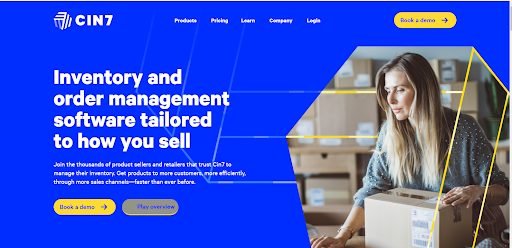
Many enterprise resource planning (or ERP) platforms feature modules for several parts of your business, including accounting software, point of sale, inventory, and shipping. This means you have a robust and integrated system, but they often charge you for each module, which can get expensive.
Cin7 offers many of these modules as standard with your plan, making it an attractive inventory management solution.
Key Features
- Inventory Management that connects products, sales channels, orders, workflows, stock locations, warehouses, and more
- Fully customizable
- Supports online selling, wholesale, and retail businesses
- Serial number tracking for easier asset tracking
Integrations
- Amazon
- Shopify
- WooCommerce
- Walmart
- Wayfair
- eBay
- Etsy
- Square
Pricing
- They designed the small business plan for companies focused on online selling. Pricing starts at $299 per month.
- They geared the next tier towards B2B and wholesale sellers. Pricing starts at $539 per month.
- The advanced version supports consumer and wholesale sales. Pricing starts at $999 per month.
- Enterprise solutions for businesses that need a more complex system are available.
Free Trial: No. However, you can book a demo.
10. Quickbooks for Inventory
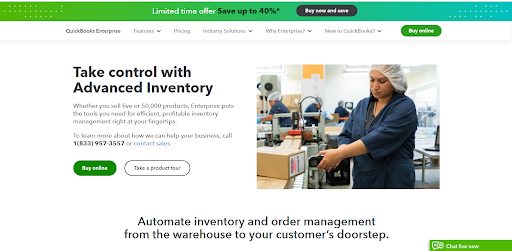
Quickbooks by Intuit is well-known for its accounting software. But its ecommerce option offers an efficient inventory management system that can handle your needs, regardless of business size.
Features
- Real-time inventory tracking and visibility
- Automated processes that eliminate critical errors for better purchase order management
- Three levels of location tracking: shelf/bin, pallet, and section area
- Immediately transfer inventory from one location to another to meet demand.
- Automated inventory forecasting
- Consolidate vendor information in one central location
- Track delivery times and shortages by vendor
- Customized inventory reports
Integrations
- Amazon
- Etsy
- Shopify
- WooCommerce
- eBay
- Squarespace
- ShipStation
Pricing
Quickbooks Commerce and Quickbooks Essentials is $50 per month (for the first three months), then increases to 100 USD per month.
More advanced enterprise options are available from $197 for the first year.
Free Trial: A 30-day trial of Quickbooks Desktop Enterprise is available.
What You Should Consider When Choosing Inventory Management Software
What are your requirements?
The first consideration before investing in inventory management software is understanding your company’s requirements. The easiest way to do this is to find out what problems you are currently having.
Is it important for you to monitor your shipment statuses? Have you had problems keeping track of inventory levels? Do you have multiple warehouses? Many inventory management platforms offer basic warehouse management functionality, such as tracking by warehouse location and automatic pick list and packing slip generation, but some small business owners find they need more options, like kitting and cycle counts.
Understanding your needs and explaining them to the vendor will not only help you choose the best software system for your company, but it will also help you get a price that fits within your budget.
Does it fit your budget?
You want the best solution for your business, but you also have a budget to consider.
Software prices are related to the complexity of your company’s needs. Obviously, a more complex system will be more expensive. Depending on the complexity of inventory levels, the number of inventory items, and business type, you may find some inventory solutions are more affordable than others…even if at first glance the price seems to be out of your budget. Check to see if there is any kind of setup fee that may influence overall affordability.
Can you start with a pared-down version before committing to the most expensive option? Most inventory management software products offer multiple plans within a price range you can afford. While not every company offers a free plan, some offer a free trial. And though some don’t offer a free trial, many offer a basic plan to help you get started. As your business grows, you can scale to a more advanced plan.
Most vendors have price tiers, and you can move up once your company has outgrown its current system. That way, you don’t have to spend much money right at the beginning.
Make sure your finances are stable enough for your chosen plan. Check your budget and decide if this is the right time to invest in technology.
Usually, the benefits will outweigh the costs—but only if you are clear about what you really need and can afford.
Fortunately, cloud-based software solutions have made it more affordable for small businesses to invest in inventory management systems. This type of software is the best option for startups, small to medium-sized businesses, or companies with low budgets.
Can it be customized?
If your company has complicated requirements, you will need to customize at least some part of your inventory management system. Consult with the software vendor to see if the software can meet your needs and be customized. Typical inventory management software has some level of flexibility for customization.
You can also see if your vendor can work with your existing inventory management system. There are situations where your current inventory system is excellent but does not offer the additional features you now need. Sometimes, you can create a robust hybrid system that supports a variety of advanced inventory management techniques, such as tracking by product type, dynamic inventory, and more.
Is It user-friendly?
It’s important not to overlook the usability of a software system. If it’s not user-friendly and takes a lot of time for your staff to learn, then it’s probably not a good option for your company.
The purpose of investing in a solution is to make your inventory management process simpler. If it’s too complicated for you and your staff, then it won’t work. One way to find out of it the software is user-friendly, other than scheduling a demo with the sales team, is to read user reviews, paying close attention to those that highlight experience with businesses like yours.
Does it integrate with other systems?
It’s important to find software that can integrate with other business systems, such as warehouse inventory management, accounting, and purchasing systems. Most inventory management software options offer a wide variety of integrations, including a range of accounting integrations and ecommerce integrations, such as your POS system and online store.
Inventory management is tied to multiple areas of your business. When your business gets bigger, you’ll be looking for software systems for these other areas as well.
It makes sense to start with a free inventory management software or one on a lower plan to test it out.
Is it flexible?
Another key factor to consider is the software’s flexibility. A few questions to ask are:
- Are mobile apps available? If not, can it still be accessed from a mobile device? Does it require an internet connection?
- How many users does it support? Can I pay for additional users if I need to or am I limited to a certain number of user licenses?
- Is it an on-premise system, or is it web-based?
- Does your system support unlimited products and unlimited locations?
Flexibility is especially important if you have warehouses that ship from multiple locations in one order or have several stores and warehouses.
Does the vendor offer good support?
Implementing a new system requires training and a certain amount of time to get up to speed. So, make sure your vendor offers training and onboarding support.
In addition, there are always issues that come up once your system is in use. It’s essential to receive prompt support for troubleshooting or additional training that you may need.
FAQs
Which Inventory Management Software is Right for Your Business?
Proper inventory management requires accuracy and the ability to forecast correctly. Errors in counting or tracking inventory or data entry can lead to money loss by making unnecessary purchases and maintaining inadequate stock levels. They can also cause shipping delays, which directly affects your customer satisfaction.
These mistakes are common when a company manages its inventory manually. That’s why we encourage businesses to look at automated software as soon as possible.
If your company takes stock of its needs and does its due diligence in choosing an inventory management software system, it will find a system that will meet its needs and budget.
It’s an investment that will provide a measurable ROI (return on investment) and allow your business to scale to the level you want.









